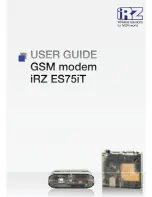
15 Basics
between ten and sixty Hz causes a shifting of this LED to the left or right by
approximately one position per 10 Hz. A shift to the right means the frequency of the
partner station is too high. A shift to the left means it is too low. If the difference is
greater than
±
60 Hz, then the next to the last tuning LED blinks.
The DPSK demodulator can only operate correctly when it knows the receive
frequency accurately to within a few hertz. Decisions of this accuracy require time.
Manually tuning the VFO or using the RIT control on the transceiver
must
therefore
cause a number of defective packets to be received, leading to repetition requests. The
highly robust and reliable automatic frequency compensation, built into the PTC-IIex,
needs a few seconds to be sure that a sudden frequency change has in fact occurred.
Manual intervention to the tuning does not normally need to be undertaken, providing the
automatic frequency parameter (
AQrg
) (refer to chapter
6.5
, page
39
) is set to ‘1’. The
PTC then adjusts itself automatically to the optimum receive frequency. The QRG display
LED can be seen to slowly but surely slide into the center position within a few minutes.
(If this should not be the case, then check the
AQrg
command is set to ‘1’, see
AQrg
command).
The tuning indicator functions also when using the ‘Listen mode’, copying PT-II signals
or - 50 Hz of the correct frequency, exactly as per the connected condition. Here
however, the operator should undertake the frequency correction manually, as the PTC-
IIex does not operate with auto QRG in the Listen mode.
15.4.3
Speed and robustness
When compared to good old PACTOR-I, PACTOR-II achieves an effective text
throughput of around 3 times that of PACTOR-I under average to poor conditions. With
very weak signals, or signals with heavy interference, PACTOR-II still works when
PACTOR-I will not allow any more data to be passed. Naturally however, the speed of
transfer, even with PACTOR-II, drops accordingly. One must get used to the fact, that,
with practically inaudible signals, one must wait 20 or 30 seconds for a new line to appear
on the computer screen. It has NOT proved to be a disadvantage to continue working with
longer packets when signals are weak or under heavy interference. The transmit buffer
naturally rapidly fills up under these conditions, causing the PTC-IIex to switch
automatically to longer packets. Only the waiting time until a new line of text appears on
the screen increases with the longer packet length, under extremely unfavorable
conditions. The effective throughput, however, remains considerably higher than when
using shorter DBPSK packets. If the link threatens to break, then the MAX Error
parameter (time-out) can be increased to 255, and the Memory ARQ parameter
(MAXSum) may be increased to 60 during the contact.
NEVER tune the VFO by hand
with very weak or inaudible signals!
With very weak or noisy signals, the PTC-IIex
adjusts its tuning very slowly to minimize tuning error. With good, to very good,
propagation conditions, PACTOR-II has shown itself to be 4 to 6 times faster than
PACTOR-I. A maximum speed of 140 characters per second can be achieved. This is
approximately 30 times the effective AMTOR speed.
Switching between speeds occurs automatically. The operator can influence this a little by
using the MAXUp and MAXDown parameter, as with Level-I PACTOR. The PTC-IIex
not only uses the packet statistics as a switching criterion, but also measures the average
179
Summary of Contents for PTC-IIex
Page 14: ...List of Figures and Tables XII...
Page 30: ...3 Installation 16...
Page 108: ...7 Audio 94...
Page 126: ...8 FAX 112...
Page 173: ...12 SYStest 159...
Page 183: ...14 Circuit Description 169...
Page 195: ...15 Basics 181...
Page 201: ...B Technical Data 187...
Page 202: ...C Layout Appendix C 19 Layout B 1 Motherboard Figure B 1 Motherboard 188...
Page 203: ...C Layout 189...
Page 215: ...Index 202...
















































